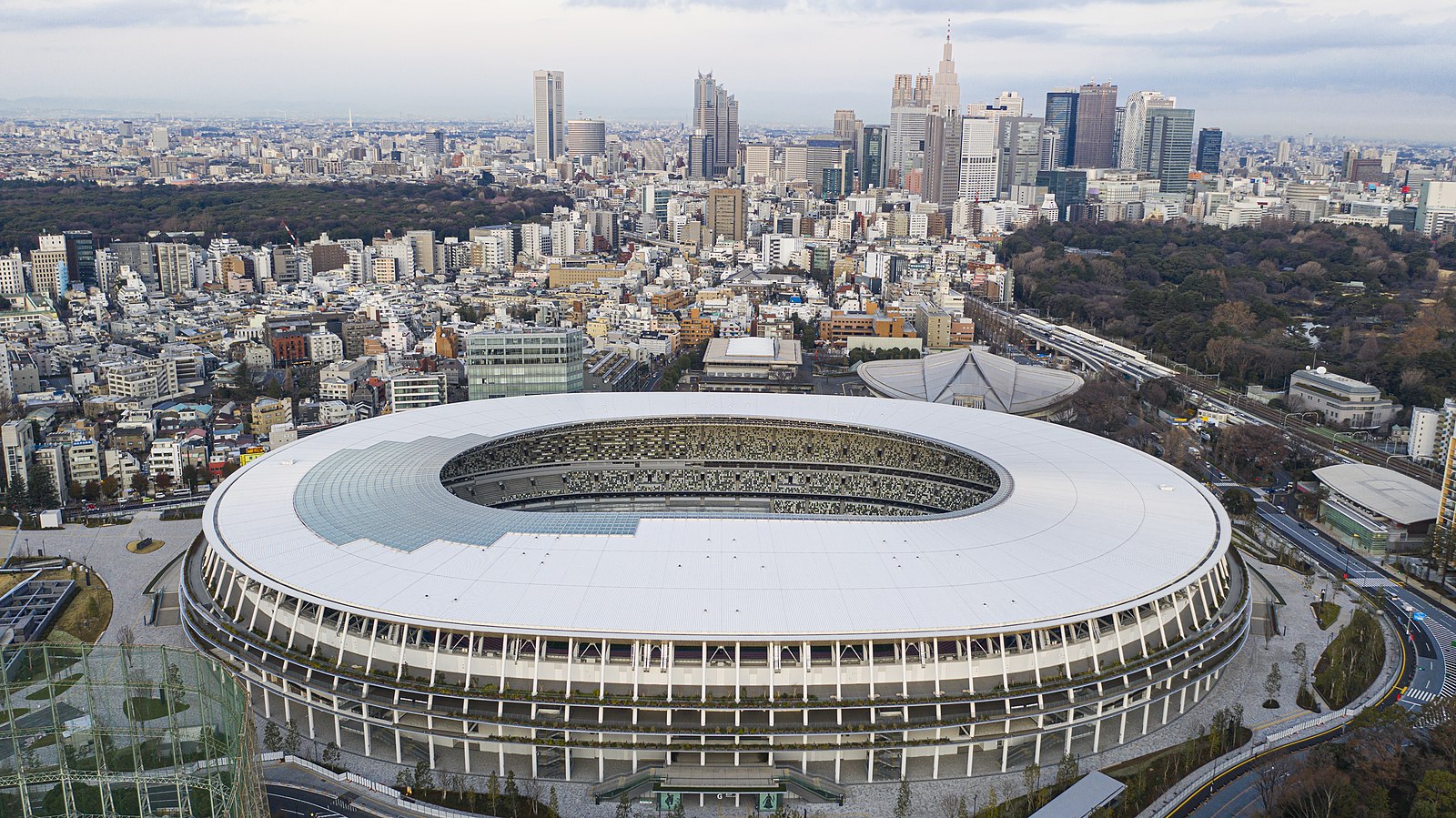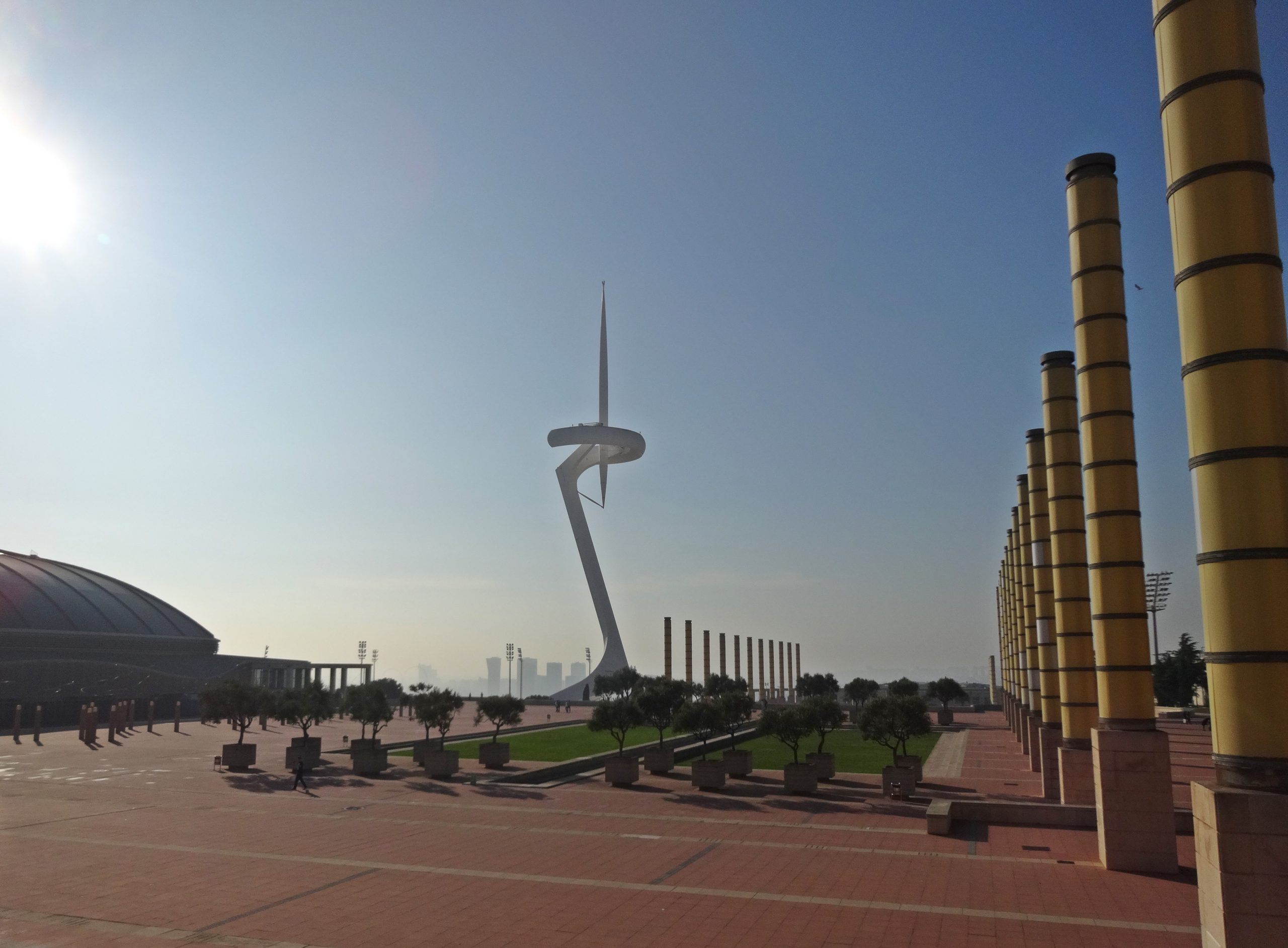
Every two years, the world’s attention turns to the Olympic Games. Athletic competitions are the center of the action, but the Games now involve political action, city-reshaping projects, and dazzling cultural displays. However, the Games are not without controversy or opposition. Activists have opposed the hosting of a rescheduled Tokyo 2020 Olympics, set to begin later this week, as Japan continues to face a covid-19 crisis. The following is the first in a collection of essays that places controversy around Tokyo 2020 in context, exploring scholarly work on opposition to the Games, urban transformations central to the contemporary Olympics, protest at the Olympic Games, and more.
In 2015, after sustained public outcry over its £1.3 billion price tag and extravagant design, Japanese PM Shinzo Abe scrapped Zaha Hadid’s design for the New Tokyo National Stadium, the stadium that was to be the 2020 Olympic Stadium. To the Japanese public, the Iranian-British architect’s design disrupted the cityscape. Others believed a Japanese architect should design the country’s national stadium. In the end, officials selected a more modest, environmentally-friendly, and economic design by Japanese architect Kengo Kuma. Five years before the COVID pandemic forced preparations into a standstill, this controversy illuminated the fraught and contested dynamics between the Olympics and local communities.
More than 125 years after the Olympics were founded, this case says much about the Olympics’ growth from a fledgling collection of competitions staged in ragtag venues to the multi-billion-dollar spectacle that now includes multi-billion-dollar urban investment projects that quite literally remake entire cities.
Olympic Urban Development
While the IOC awards bids, the burden of overseeing Olympics-related development plans requires cooperation between government and private sector actors who seek out urban investment projects. More specifically, the Olympics encapsulate the urban planning strategy known best as entrepreneurial urbanism, in which a city seeks out tourism and international investment opportunities to fund services and attract revenue. The origins of this strategy go back to the mid 1900s and the economic crises that transformed modern cities.In the postwar years, cities in Europe and North America experienced the flight of manufacturing jobs and corporate investment in the postwar years, leading city leaders to turn to private investment, tourism, and large-scale events (like concerts, conventions, and mega-events like the Olympics) as tools for job creation. At this same time, the Olympics faced an identity crisis of sorts as terrorism and financial mismanagement marred their previously desired status. Los Angeles yielded a profit from hosting the 1984 Games, which showed that hosting the event could indeed be a lucrative enterprise. With the city’s wealth of sports infrastructure, costly investment was avoided. Eight years later, in Barcelona, city and regional officials used the 1992 Games to fasttrack an existing masterplan which revitalized the city’s port, manufacturing, and working-class zones, rebranding the city as a top tourist destination and center of sports and entertainment. Solidifying the relationship between the Olympics and entrepreneurial urbanism, Los Angeles and Barcelona sparked a chapter of Olympic-generated urban development.
This model of development is not without its pitfalls. To attract tourism and investment, cities must brand themselves as safe, fun, and exciting places for tourists, business conventions, and sports teams. This approach has typically involved tax breaks for amenities like hotels, stadia, meeting space, and tourist attractions, alongside a heavy law enforcement presence in downtown areas where visitors congregate. Once working class neighborhoods near tourist attractions have experienced affordability crises as developers and property speculators seize cheap, profitable land. While these patterns often occur in cities over time, the Olympics catalyze these processes at warp speed.The sociologist Maurice Roche observes how the process of Olympics-led urban transformation varies from city to city, contingent upon planning processes, urban leadership formations, and social climates, which together produce unique legacies that endure past the close of the Games. To wit, preparations for Games in Western Europe are public-private ventures while the Moscow, Beijing, and Sochi Olympics were nearly entirely state-run. Regardless of who makes the decisions, these developments reflect a balance of local culture and global aspiration. In Worlding Cities, Aihwa Ong and Ananya Roy examine entrepreneurial cities’ quests for “world recognition in the midst of inner-city rivalry and globalized contingency” by adopting “world-class” models of development and design. Examining the designs of Olympic Villages, the Spanish geographer Francesc Munoz traces the ways individual planning regimes influence the placement, aesthetic characteristics, and long-term legacy of Olympic infrastructure, reflecting unique design traditions while hewing to international standards. In sum, the pressures exerted on cities encourage decision makers to brand locales as unique, exciting places of consumption and enjoyment, while adhering to principles set out by global design movements and IOC requirements.
The needs and interests of Olympic leaders often overlap with local long-term master plans and urban development initiatives. The IOC’s recent environmental initiatives are an illustrative example. In preparation for the 1992 Winter Olympics, held in the French Alpine town Albertville, large swathes of forest were razed to construct competition venues. Responding to widespread criticism, the IOC prioritized environmental concerns in the bidding process for future Games. At the same time, as post-industrial cities reckoned with changing social and economic realities, leaders turned to environmentally-friendly “greening initiatives” to attract sustainable investment. The urban sociologist Hillary Angelo chronicles how new building standards like LEED certifications became commonplace as urban greening projects, like New York’s High Line and Atlanta’s Beltime attract visitors and residents to former industrial zones.

Seen most notability in Barcelona, Sydney, and London’s Olympic plans, the focus on the focus on environmentalism aligned with environmentally-conscious cities’ plans to rehabilitate former industrial zones into sporting districts and tourist zones. As planning scholar Gabriel Silvestre writes, Barcelona’s Games catalyzed the city’s 1976 masterplan, transforming the city from simply a Mediterranean port city into the tourist mecca known today. Sydney’s Homebush Bay, once an industrial dumping site, was rehabilitated to serve as the Olympic Park before being converted into a residential and commercial zone. London’s new Olympic Park, in the once industrial East London neighborhood of Stratford, experienced a similar influx in investment following the close of the 2012 Olympics. However, since 2012, the formerly working-class immigrant neighborhood on the city’s east side has experienced the rising rents and affordability challenges that come along with improved amenities, luxury housing, and strengthened security installed for the Games.
As a supranational governmental body with no effective accountability or oversight except the market and its corporate sponsors, the IOC has long benefited from host cities’ willingness to meet their excessive demands. To curry favor with the IOC, candidate cities had routinely proposed glittering competition venues and extravagant accommodations. Economists Robert Baade and Victor Matheson explain that, while the IOC had been able to maintain a steady stream of interest bidding cities, recent instances of abandoned competition venues, budget overruns that cripple public finances for decades, and social impacts on impoverished communities, have produced new public opposition to staging the event, which has transformed the present landscape of bidding and hosting. Responding to this crisis of interest, the IOC implemented Agenda 2020, a comprehensive roadmap that reformed bidding procedures for candidate cities with an emphasis on sustainability and legacy planning.
As the case of Tokyo’s Olympic Stadium demonstrates, the decision-making responsibilities fall on the host government while the social and economic toll falls hardest on local residents. All the while the IOC and Olympic leaders stand on the sidelines reaping the financial windfall. The Olympics are a unique opportunity to revitalize the urban fabric, attract investment, and reshape the city’s image in popular imagination, a boon for power brokers and leaders alike.While the legacies of sporting and mega-events, like the Olympics, World Cups, and Super Bowls, are unmistakable, their disproportionately harmful effects on poorer residents has only recently received widespread recognition. With successive cases of runaway public spending, displacement, and long-term debt as a result of hosting, many academics and activists agree the Games as serving the interests of the “haves” while inflicting social harm on the “have-nots”. With pressure to build attractive venues and “clean up” the urban landscape in advance of the event, disadvantaged residents in the vicinity of venues are often the most impacted. Using the promise of jobs and improved infrastructure to sell residents on Olympic plans, city governments and organizing committees have seldom followed through on these promises after the event. These residents, most dependent on public services, are similarly disadvantaged by the austerity policies, cuts to social services, and depletion of public space frequently enacted before the Games and in their wake. Given each host city’s unique characteristics and political cultures, comparing cases is difficult. However, the scandals and push back of recent decades portends a new relationship between cities and the Olympics, one in which cities offer more modest venues and the IOC emphasizes sustainability and multi-use facilities.
Recommended Readings
Penny Bernstock. 2014. Olympic Housing: A Critical Review of London 2012’s Legacy. Farnham, Surrey: Ashgate.
Ferraguto L. Carrati. 2012. “The Role of Environmental Issues in Mega-Events Planning and Management Processes: Which Factors Count?” Pp. 109-125 in Olympic Games, Mega-Events and Civil Societies. Global Culture and Sport. London: Palgrave Macmillan.
Chris Dempsey and Andrew Zimbalist. 2017. No Boston Olympics: How and Why Smart Cities Are Passing on the Torch. University Press of New England.
Tom Gillespie, Kate Hardy, and Paul Watt. 2018. Austerity Urbanism and Olympic Counter-legacies: Gendering, Defending and Expanding the Urban Commons in East London. Environment and Planning D: Society and Space 36(5):812-830.
Richard Gruneau and John Horne. 2015. Mega-Events and Globalization: Capital and Spectacle in a Changing World Order. London: Routledge.
David Harvey. 1989. “From Managerialism to Entrepreneurialism: The Transformation in Urban Governance in Late Capitalism.” Geografiska Annaler. Series B, Human Geography 71 (1): 3–17.
John Horne and Wolfram Manzenreiter. 2006. Sports Mega-Events: Social Scientific Analyses of a Global Phenomenon. Sociological Review Monograph. Malden, MA: Blackwell Pub/Sociological Review.
Helen Lenskyj. 2002. The Best Olympics Ever?: Social Impacts of Sydney 2000. Albany: State University of New York Press.
John Karamichas. “Olympic Games as an Opportunity for the Ecological Modernization of the Host Nation: The Cases of Sydney 2000 and Athens 2004.” in Olympic Games, Mega-Events and Civil Societies. Global Culture and Sport. London: Palgrave MacMillian.
Gabriel Silvestere. 2020. “Juegos Olímpicos y Modelos Urbanos: La Influencia de Barcelona en La Estrategia de Megaeventos en Río de Janeiro (1995-2016).” IBEROAMERICANA. América Latina – España – Portugal 20 (74): 125–47.
Neil Smith. 1996. The New Urban Frontier: Gentrification and the Revanchist City. London; New York: Routledge.
Andrew Zimbalist. 2016. Circus Maximus: The Economic Gamble Behind Hosting the Olympics and the World Cup. Washington, D.C: Brookings Institution Press.
